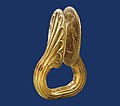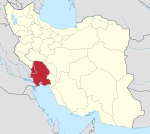Behbahan
Behbahan
Persian: بهبهان | |
|---|---|
City | |
 Ring of Power, the historical symbol of Behbahan | |
| Coordinates: 30°35′39″N 50°14′36″E / 30.59417°N 50.24333°E[1] | |
| Country | Iran |
| Province | Khuzestan |
| County | Behbahan |
| District | Central |
| Population (2016)[2] | |
| • Total | 122,604 |
| Time zone | UTC+3:30 (IRST) |
Behbahan (Persian: بهبهان)[a] is a city in the Central District of Behbahan County, Khuzestan province, Iran, serving as capital of both the county and the district.[4]
At the 2006 National Census, its population was 99,204 in 24,204 households.[5] The following census in 2011 counted 107,412 people in 29,280 households.[6] The latest census in 2016 showed a population of 122,604 people in 35,826 households.[2]
Etymology[edit]
The origin of the name "Behbahan" may be from two words: "Beh" meaning 'good, better', and "Bahan" meaning "tent." Settlers in the land may had priorly been tent dwellers, and upon building homes in the area referred to them as 'better than tents'.[7]
History of Behbahan[edit]
Historically-speaking the city came into being as a village near the Elamite era (3200-539 B.C.)[8] city of Arrajān and gradually expanded after Arrajān’s fall into ruin in the 8th/14th century[9]. Its ancient and medieval past therefore belongs to the history of Arrajan.

More precisely, the city was established by the Sasanian king Kavadh I (r. 484, 488–497 and 499–531), who in his third period of his rule launched a campaign as part of the Anastasian War against northern Roman Mesopotamia, and deported 80,000 prisoners from Amida, Theodosiopolis, and possibly Martyropolis to Pars and Khuzestan provinces, some of whom are thought to have built the city of Arrajan. The people of the Amida region were experts in linen production, and Arrajan quickly became a center of this product.
During Marun dam road construction work in 1981, important finds were made at the Arrajan site near a ruined bath-house and a shrine on the bank of the Marun river: a gilded metal coffin, some gold buttons, various weapons, a large candlestick, pieces of pottery and metalwork, figurines, and a very ornate gold object bearing a representation of two fierce, winged lions and a short inscription in a cuneiform script. These finds, which have been moved[10] to the Museum of Ancient Iran in Tehran, are under study by Iranian archeologists, who consider them to be from the later part of the last period of Elam.
The main archeological sites and historical remains in the present county of Behbahan, anyways, are listed below: Arjan bowl of Elamite king KIdin-Hutran, Arjan Ring of Power[11][12] from Elamite[13] era, remains of the ancient town of Beh az Amed-e Kavad and Arrajān north of Behbahān city; remains at the entrance to the Takab canyon; Islamic remains (mosques and shrines of saints) in Behbahān city; remains of a Sassanid era bridge and fire-temple and of a traditional Safavid period school in the village of Kheyrabad; remains of a castle called Qaḷʿa-ye Dokhtar[14] (literally meaning Daughter castle) on the bank of the Kheyrabad river; ruins at Zeydun, Sardasht, Dej-e Kalat, and Dej-e Golab[15].
Gallery[edit]
-
A replica of Arjan bowl
-
Ring of Power Statue, Symbol of Ancient Behbahan (Arjan Square)
-
Ruins of Arjan Briges on Marun River in Northern Behbahan
-
Arjan Ring of Power from Elamite king Kidin-Hutran
-
Marun Dam Public Resort
-
An outpost from Sassanid Era near Borj village, Behbahan
-
Main souvenir of Behbahan, daffodils
-
Bowl of Arjan
-
Ruins of Arjan town walls in northern Behbahan
-
1950s map of Behbahan
-
Ruins of a Nestorian church in Tashan village, Behbahan
Climate[edit]
Behbahan has a hot semi-arid climate (Köppen: BSh), characterised by sweltering and rainless summers and pleasant winters with occasional heavy rainfall.
| Climate data for Behbahan (1991-2021) | |||||||||||||
|---|---|---|---|---|---|---|---|---|---|---|---|---|---|
| Month | Jan | Feb | Mar | Apr | May | Jun | Jul | Aug | Sep | Oct | Nov | Dec | Year |
| Mean daily maximum °C (°F) | 16.7 (62.1) |
18.9 (66.0) |
24.4 (75.9) |
30.5 (86.9) |
38.2 (100.8) |
42.9 (109.2) |
44.3 (111.7) |
44.1 (111.4) |
40.3 (104.5) |
34.6 (94.3) |
24.2 (75.6) |
18.5 (65.3) |
31.5 (88.6) |
| Mean daily minimum °C (°F) | 6.0 (42.8) |
7.2 (45.0) |
10.5 (50.9) |
15.5 (59.9) |
21.1 (70.0) |
25.4 (77.7) |
28.2 (82.8) |
27.9 (82.2) |
23.9 (75.0) |
19.2 (66.6) |
12.6 (54.7) |
7.9 (46.2) |
17.1 (62.8) |
| Average rainfall mm (inches) | 117 (4.6) |
75 (3.0) |
69 (2.7) |
28 (1.1) |
6 (0.2) |
0 (0) |
0 (0) |
1 (0.0) |
1 (0.0) |
5 (0.2) |
74 (2.9) |
116 (4.6) |
492 (19.3) |
| Source: Climate-data.org | |||||||||||||
See also[edit]
Notes[edit]
References[edit]
- ^ OpenStreetMap contributors (27 July 2023). "Behbahan, Behbahan County" (Map). OpenStreetMap. Retrieved 27 July 2023.
- ^ a b "Census of the Islamic Republic of Iran, 1395 (2016)". AMAR (in Persian). The Statistical Center of Iran. p. 06. Archived from the original (Excel) on 21 October 2020. Retrieved 19 December 2022.
- ^ Behbahan can be found at GEOnet Names Server, at this link, by opening the Advanced Search box, entering "-3055917" in the "Unique Feature Id" form, and clicking on "Search Database".
- ^ Habibi, Hassan. "Approval of the organization and chain of citizenship of the elements and units of the national divisions of Khuzestan province, centered in the city of Ahvaz". Islamic Parliament Research Center (in Persian). Ministry of Interior, Political and Defense Commission of the Government Board. Archived from the original on 17 July 2014. Retrieved 25 January 2024.
- ^ "Census of the Islamic Republic of Iran, 1385 (2006)". AMAR (in Persian). The Statistical Center of Iran. p. 06. Archived from the original (Excel) on 20 September 2011. Retrieved 25 September 2022.
- ^ "Census of the Islamic Republic of Iran, 1390 (2011)". Syracuse University (in Persian). The Statistical Center of Iran. p. 06. Archived from the original (Excel) on 18 January 2023. Retrieved 19 December 2022.
- ^ "Meaning of Behbahan - معنى بهبهان". 14 July 2011. Archived from the original on 14 July 2011. Retrieved 6 February 2021.
- ^ Mark, Joshua J. "Elam". World History Encyclopedia. Retrieved 30 May 2024.
- ^ Foundation, Encyclopaedia Iranica. "Welcome to Encyclopaedia Iranica". iranicaonline.org. Retrieved 30 May 2024.
- ^ "The Elamite Period – National Museum of Iran" (in Persian). Retrieved 30 May 2024.
- ^ "معرفی هفت شاهکار زرین هنر ایران در موزه ملی ایران (حلقه قدرت ارجان) – موزه ملی ایران" (in Persian). Retrieved 30 May 2024.
- ^ 2487 (29 September 2019). "نمایش «حلقه زرین ارجان» در سرزمین مادری". ایرنا (in Persian). Retrieved 30 May 2024.
{{cite web}}:|last=has numeric name (help) - ^ "Arjan Bowl Selected as Iran's Symbol at Tokyo 2020 - Sports news". Tasnim News Agency. Retrieved 30 May 2024.
- ^ "مروری بر قلعههای ارجان". ایسنا (in Persian). 22 July 2012. Retrieved 30 May 2024.
- ^ Foundation, Encyclopaedia Iranica. "Welcome to Encyclopaedia Iranica". iranicaonline.org. Retrieved 30 May 2024.
External links[edit]















